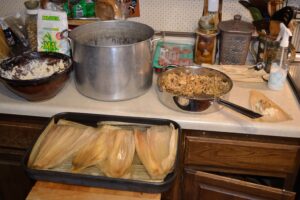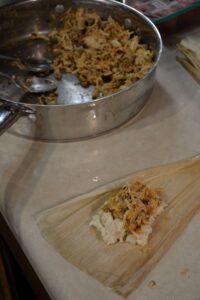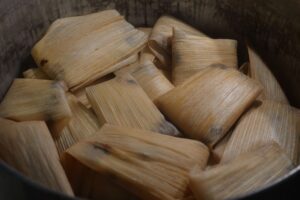Rose and I enjoy making tamales over the holidays. Some of our fondest memories of traveling in Mexico in December are having tamales, fruit, and hot chocolate for breakfast or lunch. By making large batches of tamales and freezing single-meal packs, we’re able to enjoy tamales like this on occasional weekends throughout the year.
Tamale filling
3 lbs. meat (moose, caribou, or chicken)
1 lb. mild pork sausage
2/3 cup of lentils, cooked
chilpotle peppers, flaked, to taste (~1-2 Tbsp or more)
salt to taste
For speed, I like to first pressure cook the moose or chicken on high for 40-50 minutes so it flakes nicely. I first cut it across the grain in ~1-inch-thick pieces. Once it’s going, we start the corn husks soaking next. We buy a lot and soak them in batches as we go, using warm water.
As the pressure cooker is finishing, start frying up the pork sausage in a large pan. A potato masher does a nice job of breaking the pork up into small pieces. When it’s cooked, I do the same with the flake-meat as I drop it from the pressure cooker into the big frying pan. Then I add chiles to taste and salt, too (if needed; pork sausage can be quite salty). Lastly, I add the lentils, which take about ten minutes to cook and when timed right come out done just as the pressure cooker is winding down. Taste the filling again before taking it off the burner. You want it a little on the strong side, because it’s being combined with the much milder masa.
Three cups of water in the pressure cooker makes a good broth for some of the masa. Rose is the expert here. She makes three batches at a time, which is the largest amount our big bowls can easily handle as we hand mix it all together. It usually takes more for the meat in the pan; we just mix up another three or more batches as needed.
Tamale dough (masa)
2 C masa de harina
2 C lukewarm water or broth
1 tsp baking powder
½ tsp salt
2/3 C vegetable shortening or lard
Whip the shortening on high for 5 minutes. Combine masa, baking powder, and salt in a bowl, work broth/water with hands or spatula to make soft, moist dough. Add whipped shortening and masa until it makes a nice, spongy texture. (We no longer use any lard, and the taste is still excellent.)
When the dough and filling and corn husks are ready, we get our large canning kettle ready to steam the tamales: insert the bottom shelf thing (a stand with holes in it that jars sit on to keep them off the bottom), and put an inch or so of water in the bottom. Then we assemble all four containers (filling, dough, soaking husks, and steamer) in a way that both of us can reach everything.
Then, using our hands and a large spoon in each ingredient container, we assemble the tamales on top of the corn husks on the counter, one at a time (each; we’re both working on one side of the assembled containers and reaching across for meat or dough). This takes a little patience until you get in the swing of it. You don’t have to be particularly careful, just roughly accurate with the amount of ingredients you can get inside of a wrapped corn husk. The husk size and configuration affect this; big ones are great, but you often have to use two to get it to work. And you can use strips of husk to tie up tamales that aren’t staying put properly.
We just plop a slug of dough on the husk, make a dent in it with the spoon and maybe shape it a little with our fingers, then plop meat filling on top, herd everything into place with fingers, then wrap the sides of the husk one at a time so they overlap on the top, and finally bend the ends up over the top. Now, hold the whole thing in place, flip upside down, and lay it in the steamer. If all went well, gravity will keep things in place. If not, try ties and/or place another tamale on top of it to keep the ends bent in.
We steam the tamales for two hours. After eating a few, we usually let the batch cool overnight and then vacuum-pack them four to a bag and put them in the freezer.
Getting quantities right is always a bit of a challenge, but be bold and experiment. You can’t go wrong with the ingredients, and the end result tastes great no matter how it looks.
This year we began experimenting with a meatless version, centered on Magic Beans.
Oh—when we cook the frozen ones we prefer to take them out of the plastic bag and put them frozen into a steamer for 20 minutes. This seems to keep them nice and moist. We like to drench them in salsa or mole, sometimes on top of over-easy eggs.




